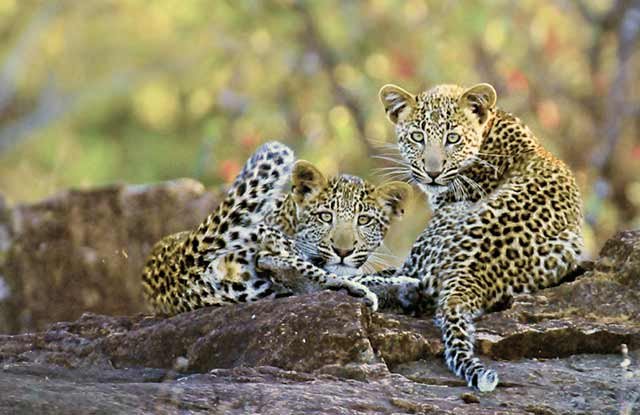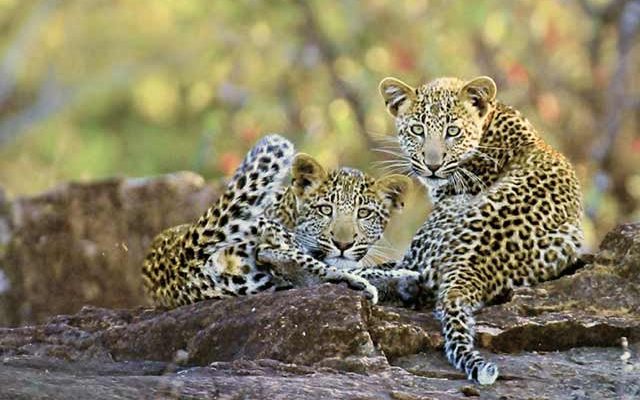
But there’s so much more to these incredible animals than meets the eye. From their unique hunting skills to their elusive nature, African leopards are full of surprises. Whether you’re an animal lover, a budding naturalist, or just someone curious about wildlife, diving into the world of African leopards is like opening a treasure chest of fascinating facts. So, let’s explore the top ten that will deepen your appreciation for these sleek felines.
1. Expert Climbers and Hiders
African leopards are not just pretty faces; they’re also incredibly skilled at climbing. Their strong shoulders and powerful limbs allow them to scramble up trees with ease. You might even find them lounging on a branch, resting or keeping an eye on their surroundings. This ability is more than just for show; it helps them escape predators and store food away from scavengers.
Speaking of food, did you know they sometimes drag their kills up into the trees? This behavior protects their meals from other animals, like lions or hyenas, who would love to steal a leopard’s hard-earned dinner. Imagine an acrobat, deftly balancing on a tightrope—this is how agile and clever these big cats are when it comes to finding safety.
2. Unique Coat Patterns
Have you ever noticed how no two leopards look exactly alike? Their coats are covered in distinctive spots called rosettes, which serve a practical purpose. These spots help them blend into their environment, making it easier to stalk prey. It’s like nature’s version of camouflage! You might be wondering why this matters so much; well, when you’re a solitary hunter, staying unseen is key to your survival.
The patterning is also unique to each leopard, similar to a fingerprint in humans. This individuality can help researchers track specific leopards in the wild. Just picture scientists in the field, carefully observing these beauties using their unique markings to understand their behaviors and territories better.
3. Solitary Behavior
Unlike some other big cats that love to hunt in packs, the African leopard is primarily solitary. They prefer to roam alone, marking their territory with scent markings and scratches on trees. This isn’t just a case of wanting personal space; being solitary helps them avoid competition for food, which can be pretty fierce in their habitats.
When it’s time to mate, leopards will come together briefly, but otherwise, they stick to their own paths. This behavior might seem lonely, but it allows them to explore vast territories and hunt effectively without sharing their meals. Imagine having your own personal kingdom to roam and rule—that’s what life is like for these independent felines!
4. Masterful Hunters
African leopards are truly master hunters. They have a diverse diet, which can include everything from antelope to birds and even insects. They’re known for their stealthy stalking techniques, using their keen eyesight and hearing to pinpoint their prey’s location. When the moment is right, they burst into action, often leaping up to 10 feet in a single bound.
This impressive skill set isn’t just luck; it’s a combination of practice and instinct. Young leopards learn to hunt by observing their mothers, who are patient teachers. You can almost picture a mother leopard and her cubs sneaking through the grass, playful yet focused, as they work together to catch breakfast.
5. Exceptional Adaptability
One of the most incredible traits of the African leopard is its adaptability. These cats can thrive in various environments—from dense forests to open savannas. They are like the ultimate survivalists, able to adjust their hunting strategies and behaviors to match their surroundings.
For instance, in areas with less prey, leopards might hunt smaller animals or even scavenge when necessary. Their ability to adapt doesn’t just apply to their diet; they also adjust their patterns of activity based on the presence of competitors. Imagine being able to change your routine to fit any situation—a vital skill in the wild!
6. Communication Skills
While leopards are mostly solitary, they still communicate with each other using a range of vocalizations and body language. You might hear a leopard’s distinctive growl or yowl echoing through the night. These sounds serve different purposes, from warning others to marking territory.
Body language plays a significant role as well. A leopard might arch its back or flash its whiskers to show dominance or submission. It’s essential to understand these signals, especially for researchers or wildlife enthusiasts observing them in the wild. Picture a dramatic interplay of sounds and postures, each telling a story of emotion and intention in the heart of the African wilderness.
7. A Short but Sweet Life Cycle
The life cycle of an African leopard is both fascinating and poignant. In the wild, these magnificent creatures generally live about 10 to 15 years, but various factors can affect their lifespan, including habitat quality and the presence of threats.
Leopard cubs are born blind and rely heavily on their mothers for protection and sustenance. They’ll stay with her for about two years, learning crucial survival skills. After that, they start to venture out on their own. It’s a bittersweet transition, much like watching a child graduate and step into the world. The bond between mother and cub is strong, but the pull of independence is equally powerful.
8. Conservation Status
Sadly, African leopards are facing challenges that put their future at risk. Habitat loss due to human activities, along with poaching and conflict with local communities, are significant threats. Their populations are declining in some regions, highlighting the need for conservation efforts.
Many organizations are working hard to protect these beautiful animals and their habitats. Programs that educate local communities about the importance of leopards in the ecosystem are essential, as they help foster coexistence rather than conflict. Just think about how impactful it is to engage people in protecting wildlife—it’s a win-win situation for both humans and leopards.
9. Cultural Significance
Throughout history, leopards have held a special place in many cultures. In African folklore, leopards are often seen as symbols of strength, courage, and mystery. Their stunning coat and impressive hunting skills have inspired countless stories, paintings, and even tribal designs.
In some regions, wearing leopard skin has been a sign of nobility or bravery, much like how certain birds are revered in other cultures. The leopard’s image can also be seen on flags and emblems, showcasing its importance in the cultural identity of various communities. Can you imagine how many stories have been shared around a fire, celebrating the beauty and power of these magnificent creatures?
10. The Future of the African Leopard
The future of the African leopard hinges on conservation efforts and raising awareness about their plight. By supporting wildlife organizations and initiatives aimed at protecting their habitats, we can help ensure these incredible cats continue to roam the African landscapes.
Every little effort counts, whether it’s reducing conflicts with local farmers, promoting eco-tourism, or simply spreading the word about the importance of leopards in our ecosystems. It’s like dropping pebbles into a pond; each pebble creates ripples that can lead to meaningful change. Together, we can make a difference for the African leopard, ensuring that future generations experience the wonder of these amazing animals.
In conclusion, the African leopard captivates our imagination with its grace, strength, and adaptability. By understanding these ten fascinating facts, we can foster a deeper appreciation for them and the ecosystems they inhabit. Next time you hear a story about leopards, or perhaps spot one on a safari, remember that there’s a lot more to this incredible cat than meets the eye.

